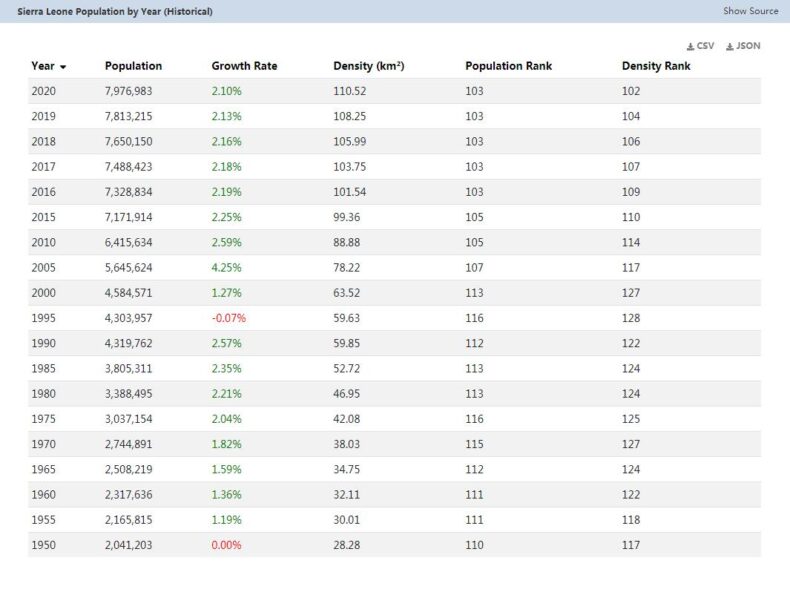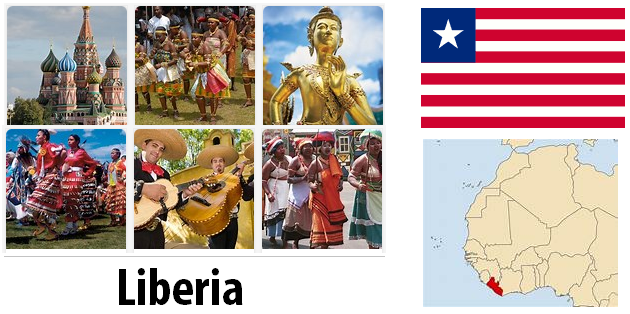Sierra Leone is undeveloped for tourism, but offers impressive landscapes and a wildlife that is still rich in species despite the past civil war.
The political situation in Sierra Leone has only recently calmed down, but travel through the country can only be realized through the missing and destroyed infrastructure (but not impossible). Possible travel destinations are primarily places on the coast where the beaches are completely untouched by tourism.
The population of Sierra Leone is made up of many different ethnic groups. The cultural differences and the mixing of the different languages provides a colorful picture. The largest population group are the Mende, which make up around 30.6 percent. This is closely followed by the threshing floor, which accounts for 29.4 percent. The Limba and Kono as well as Bullom-Sherbro, Fula, Peul, Mandingo, Kruanko, Susu, Yalunko, Creoles, Krio, Kissi and Vai are the other ethnic groups that are in the minority to the two large population groups.
Linguistically, there is a mix of different dialects and languages of the respective ethnic groups in Sierra Leone. English is the official language here, but is only spoken by a minority in Sierra Leone. Over 95 percent speak the Krio language as a mother tongue or a second language. This is based on the English language which gradually mingled with local languages. 30 percent of the population speaks Teutonic. The language of the Mende is also very common.
Not only linguistically there are differences between the ethnic groups of Sierra Leone, the religion is also very different. About 60 percent of the population are followers of the Sunni Muslim faith, another 10 percent are Christians. Around 30 percent do not profess any religion or belong to the traditional African religious groups.
Area: 71,740 km² (land 71,620 km², water: 120 km²)
Population: 5.4 million people (July 2011, COUNTRYAAH.COM). 90% of the population is made up of 20 African peoples, the largest of which are Mende and Temne (30% each), as well as Limba, Kono, Bullom-Sherbro, Fulbe, Kuranko, Yalunka and Kissi. The remaining 10% are Creoles (descendants of freed Jamaican slaves who settled in the Freetown area in the late 18th century), civil war refugees from Liberia, Europeans, Lebanese, Pakistanis, and Indians.
Population density: 75 people per km²
Population growth: 2.249% per year (2011, CIA)
Capital: Freetown (835,000 residents, 2007).
Here is a current list of the largest cities in Sierra Leone.
Highest point: Loma Mansa (Bintimani), 1,948 m
Lowest point: Atlantic Ocean, 0 m
Form of government: Sierra Leone has been a presidential republic since 1978 and is represented in the Commonwealth. The constitution dates from 1991. The parliament is made up of 124 members, 112 are directly elected, 12 are elected by local chiefs in separate elections. Sierra Leone has been independent of Great Britain since April 27, 1961.
Administrative division: 3 provinces (Eastern, Northern and Southern) and the Western area (around Freetown).
Head of government and Head of state: President Ernest Bai Koroma, since September 17, 2007
Language: The official language in Sierra Leone is English, but this is spoken only by the literate minority. Mende is the main language in the south, Temne in the north Creole (Krio) is the mother tongue for only 10% of the population, but is understood by 95% and is therefore used as a colloquial language in the country.
Religion: 60% Muslim, 30% followers of traditional religions, 10% Christians
Local time: CET – 1 h
In Sierra Leone there is no change between summer and winter time.
The time difference to Central Europe is -1 h in winter and -2 h in summer.
Telephone area code: 00232 or +232
Internet ID:.sl
Mains voltage: 220/240 V, 50 Hz, an adapter is recommended
Geography
The Republic of Sierra Leone, located on the west coast of Africa, borders the Republic of Guinea in the northwest, north and northeast and Liberia in the southeast. In the south of Sierra Leone is the Atlantic Ocean.
Here you can find a detailed topographic map of Sierra Leone.
Sierra Leone has a convenient location on the Atlantic. The coastline in the southwest is strongly structured by small bays, lagoons, wide estuaries and islands. Some coastal regions have up to 112 km long sand banks.
A plain up to 110 km wide runs along the coast, on the Freetown Peninsula the Sierra Lyoa Mountains rise to heights of up to 1,000 m.
Behind the humid coastal plain begins the partly agricultural forest area, through which large rivers (including Rokel, Sewa, Moa) flow. The country rises to the eastern Guinea Highlands, a high plateau with elevations of over 1,830 m in the Loma Mountains and Tingi Hills. The highest mountain is the Bintimani with 1,948 m.
To the southeast, the height of this plateau decreases to 150 m. The plateaus pass relatively suddenly into a wave-like plane. Domestic traffic is severely hampered by this. The sharp drop also affects precipitation and thus plant growth. The level is no higher than 150 m, with the exception of some hills that reach a height of 400 m to 535 m.
Further to the southeast is an area with swamps, lagoons and bays.
Sierra Leone owes its name (Lion Mountains) to the mountain ridge (890 m) visible from the sea between Cape Sierra Leone and Cape Shilling.
The eastern border with Guinea runs on the watershed between the area that flows down to the Atlantic and the area that drains over the Niger.
Population in Sierra Leone
This map of Sierra Leone’s population distribution was created by the Worldmapper team. Densely populated areas appear bloated, the area of sparsely populated areas is reduced. The shape of the grid has been preserved; an underlying map with the original geographical extent helps interpret the map. The distorted map should help to present abstract statistical information clearly.




